
http://www.iaeme.com/IJM/index.asp 99 editor@iaeme.com
International Journal of Management (IJM)
Volume 8, Issue 6, Nov–Dec 2017, pp. 99–108, Article ID: IJM_08_06_012
Available online at
http://www.iaeme.com/ijm/issues.asp?JType=IJM&VType=8&IType=6
Journal Impact Factor (2016): 8.1920 (Calculated by GISI) www.jifactor.com
ISSN Print: 0976-6502 and ISSN Online: 0976-6510
© IAEME Publication
ADAPTIVE PERFORMANCE IN VUCA ERA
– WHERE IS RESEARCH GOING?
Chandibai Potsangbam
Research Scholar, Department of Business Administration,
Assam University, Silchar, India
ABSTRACT
Adaptive performance in the work environment refers to adjusting to and
understanding change in the workplace. Adaptive performance can be understood as
altering behavior to meet new demands created by the novel and often ill-defined
problems resulting from changing and uncertain work situations. Adaptive
performance is a context specific term, individual adaptive performance, team-group
adaptive performance, organizational adaptive performance. In the volatility,
uncertainty, complexity and ambiguity (VUCA) no other performance is relevant due
to high speed change. To match and sustain with VUCA situation adaptive
performance can play as innermost theme need more research on researches to
discover responses. This paper explores how and where the researches on adaptive
performance are moving under the constraints and guidelines for VUCA environment.
The methodology adopted here is review based content analysis.
Key words: Environment, Skills, Researches, Future skills.
Cite this Article: Chandibai Potsangbam, Adaptive Performance in VUCA Era –
Where is Research Going?. International Journal of Management, 8 (6), 2017, pp. 99–
108. http://www.iaeme.com/IJM/issues.asp?JType=IJM&VType=8&IType=6
1. INTRODUCTION
“We cannot direct the wind but we can adjust the sails”.
We are in the world at the 21st century. The characteristics and attributes of 21st century
symbolizes as it was described in the acronym i.e. VUCA. Contextually we are the VUCA-
world. The thematic parlance of VUCA is one that stands for Volatile, Uncertain, Complex
and Ambiguous and together these represent how it feels to be doing business and designing
strategy in the world right now. According to Kinsinger & Walch (2012), stated that the
notion of VUCA was introduced by the U.S. Army War College to describe the more volatile,
uncertain, complex and ambiguous, multilateral world which resulted from the end of the
Cold War. It is subsequently adopted by the strategic business leaders to describe the chaotic,
turbulent, and rapidly changing business environment that has become the ―new normal‖
(Kishinger, P & Walch, K, 2012). VUCA is now available as a stand-alone environmental
factor which enforces the entities in uncertain times which compels in utilization of the

Chandibai Potsangbam
http://www.iaeme.com/IJM/index.asp 100 editor@iaeme.com
capacity the leaders to take action in uncertain situation. The four VUCA dimensions can be
explained as hereunder;
(i) Volatility: Dynamic, quick and intense changes in the environment where the challenge is
unexpected or unstable and maybe of unknown duration.
(ii) Uncertainty: A lack of predictability around issues and events where the nature of the
event may be known, but it is impossible to predict its presence or outcomes in advance.
(iii) Complexity: The combination of issues and the chaos that surrounds any organization, in
which the situation has many interconnected parts and variables where some of the
information may be available or could be predicted, but the volume or nature of it can be too
overwhelming to process.
(iv) Ambiguity: The haziness of reality and the mixed meanings of conditions in which casual
relationships are completely unclear where no precedents exist, and have to face ―unknown
unknowns‖.
Organizations and managers are struggling to stay afloat and aligned in the volatile,
uncertain, complex, and ambiguous nature of today‘s global business environment.
Turbulence—the rapid rate of change—is swirling around many of us, that tipping us the way
for which we attempt to navigate for safe passage through VUCA
(https://thunderbird.asu.edu). Due to the volatility, uncertainty, complexity as a result of
changes occurring in today‘s organizations, adaptive performance has become increasingly
important in work environments. According to Hoover & Feldhusen, and et.al. (1990),
adaptive performance is considered as general intelligence, problem understanding, and
problem solving constructs which make unique contributions to creative problem solving
performance. A world that requires effective leaders is one with greater implications for
sound decision making, high confidence, and ready adaptability.
The adaptive performance is components of Individual performance have attracted the
attention of many researchers in line of organizational behavior, human performance sciences,
and psychologist of the world. Especially, the behaviorists, the psychologist, the management
professionals, the educationists in the world are running behind the uncommon pursuit of
exploration in quest of how to instill the adaptive performance among individuals, learners,
workers, and in organization. From this deportment the researchers discovering in the pursuit
of process, knowledge, and applications of adaptive performance which having abundant
evidences be primarily classified with the help of a meta-taxonomy without going too much
detail. Obviously, following a simplistic format of classification of available evidences on the
study on adaptive performance is posited in the following heads, they are- adaptive
performance in education & learning, training, competence; adaptive performance in the
context of leadership; adaptive performance in the group behavior and organizational context.
A few pioneering studies concentrating on the assessment, processes, and systems perspective
of adaptive performance related conditions or the other contexts which cannot be overlooked.
Therefore, the following section highlights the evidences of researches on the areas as stated
above are furthered here.
2. ADAPTIVE PERFORMANCE IN LEARNING, TRAINING &
COMPETENCES
Performance oriented learning is aimed at developing a set of competencies allowing adaptive
behavior to deal successfully with either domain-specific problems or issues arising on the
cross sections of different professional fields (Kommers, P.,& et.al., 2008). The development
of adaptive software applications for educational and training purposes has been dominated

Adaptive Performance in VUCA Era – Where is Research Going?
http://www.iaeme.com/IJM/index.asp 101 editor@iaeme.com
by instructional design solutions exploring level of knowledge as a single learner‘s
characteristic determining effective individualization of learning (Corbalán-Pérez, Kester,
and van Merriënboer, 2006; Merrill, 2002; Oughton& Reed, 2000; Wisberg, 2003). There is
indication on the investigation on adaptive performance within specific contexts, particularly
training and learning environments. This research tended to utilize a laboratory context and a task-
change paradigm wherein AP is indicated by performance on a learned task after difficulty or
complexity increases (e.g., Lang & Bliese, 2009; LePine et al., 2000). The authors Han, T. Y., &
Williams, K. J. (2008) also conducted a multilevel investigation of adaptive performance for
exploring the connection of individual- and team-level relationships.
Adaptive Performance in the Context of Leadership
In an ever changing (VUCA) environment organizations will need to develop more adaptive
and responsive leadership skills across the organization. Leadership is no longer simply the
domain of our senior management teams, in which our employees too will need to be
equipped to relate, connect and respond to challenges and opportunities. The need for new
leadership approaches for leading an organization in complex and uncertain times implies an
ability to understand the patterns of cause and effect and connects the dots to uncover
opportunities that are not yet clear. However, it involves the ability to perceive what is ―over
the horizon‖ of our current field of view accessing deep intuition and using imagination to
envision the future point (www.innovationpeope.co.in). A study conducted by Griffin and
et.al. (2010) on leader‘s vision and the development of adaptive and proactive performance of
leaders explained from the longitudinal perspective.
In one of the Harvard Business Review, a study showed a strong link between leadership
skills and the bottom line sighting to those companies who can attract the best people, who
can lead and problem solve consistently outgrow their competitors. Yet many organizations
fail to recognize the talent needed in the organization, struggle to identify potential, or
mismanage the development needs of high-potential people. Bassie, L. & McMurrer, D.
(2007) also mentioned that leadership in context with adaptive performance, need to be able
to learn rapidly, continuously communicate and involve, and be flexible in their responses and
develop ―just-in-time‖ solutions rather than waiting for perfect solutions.
On Adaptive Performance of the Group Behavior
Individual work performance is a hot issue which plays an important role in our day to day
workplace that has not only grasped companies all over the world but also fueled a great deal
of research fields of management, occupational health, and work and organizational health
(Waldman, 1994; Evans, 2004; Lerner. D & Mosher, H. R, 2008; Campbell, 1990, Linda
Kopman, 2011). In all the research fields mentioned earlier, individual work performance is
an abstract, latent construct that cannot be pointed to or measured directly. On context with
adaptive performance, Viswesvaran and Ones defined work performance as whole, as
―scalable actions, behavior and outcomes that employees engage in or bring about that are
linked with and contribute to organizational goals‖. On this ongoing globalization of the
economy, individual work performance is considered as an important in bringing the light of
the current economic recession and sustainable employability (Linda. K, 2014). Charlene. K.
Stokes, Tamera R. Schneider, Joseph B, Lyons (2010) critically evaluated the issue on and
detected some criterion for assessment under tge caption title ―adaptive performance; a
criterion problem‖. Han. T. Y & William. K. J (2015) examined the relationship of adaptive
performance at individual and team level, also examined this in the context of group, and also
suggested the methods of assessment at multi-level under the caption ―multilevel

Chandibai Potsangbam
http://www.iaeme.com/IJM/index.asp 102 editor@iaeme.com
investigation of adaptive performance‖. Burke, and etal, (2006) made the analysis for team
adaptation to made the conceptual analysis.
On Adaptive Organization
Performance support systems in business and industry target can increase in individual and
organizational performance as learning is expected to occur as a side effect of performance.
VUCA is a ‗situational diagnostic‘. It zooms in on the current context facing organizations
and leaders and provides the vital perspectives that are then converted into an action plan. It is
an action oriented tool, designed to inform, equip and guide leadership action. The VUCA
model identifies the internal and external conditions affecting organizations today. The
VUCA Prime was developed by Bob Johansen, distinguished fellow at the Institute for the
Future and the author of Leaders Make the Future: Ten New Leadership Skills for an
Uncertain World. He proposes that the best VUCA leaders are characterized by vision,
understanding, clarity, and agility –the ―flips‖ to the VUCA model. It can be seen as the
continuum of skills leaders which can develop to help make sense of leading in a VUCA
world. HR and talent management professionals can use as the VUCA Prime as a ―skill and
abilities‖ blueprint when creating leadership development plans (Lawrence. K. 2013). Linda
Koopmans, et.al. (2011) attempted to describe conceptual frameworks of individual Work
Performance made only a review. Kenney, S. (2009) stated the strategic aspects addressing
the challenges need to face by an adaptive organization in VUCA environment. Kenney stated
that to align with changes, an organization need to focus on the five areas to remain relevant
and effective in face of change and dynamism. The main key dimensions are- the people- the
benefits to youth/talents in organization; secondly, the process- fostering collaboration;
thirdly, the strategies of the organization; fourthly, the structure- creating and open
collaborative workforce; and in fifth, the technology- enabling knowledge transfer.
On Assessment of Adaptive Behavior
Adaptive behavior assessment or assessment of the daily performance of activities required
for personal and social sufficiency. It has typically been assumed that what constitutes
individual work performance differs from job to job which result having countless measures
of work performance has been used (Tuber. T & et.al, 2011). Calnon, M. K. (1984) framed
the adaptive scale on contributions of race and grade to domain scores on wine lane adaptive
behavior scale. Campbell, V. Smith, R. and Wool, R. (1981) also constructed adaptive
behavior scale for assessing the difference in scores of mentally retarded individual referred
for institutionalization. Similarly, Engleman. D (1974) conducted study under the title
―quantitative study of adaptive behaviour of Ohio educable mentally retarded and normal
children‖. Given. T. (1998) also assessed reliability on adaptive behavior scale under the
subject of psychology in school. Helpern. & et.al. (1979) examined the alternative approaches
for adaptive behvaiour. Harrison, P. L (1981) stated on mercers adaptive behavior inventory.
Heath, C. P (1986, April) trends in adaptive behavior research over the past decades stated
about where and how the research trend on adaptive behavior moves toward.
The studies on assessment and on the attempt to assess adaptive behavior in the
context of mentally retarded person in USA and other western countries had have started
since 1967 onward; also observed that since 1981-2014 the trend of constructing such scale
was more. Many of such researches attempted during this period was concentrated mostly on
adaptiveness of mentally retarded or challenges subjects on interest under the discipline of
medical psychology, or in general psychology, as well as in educational psychology. These
scales did not concentrate on adaptive performance in the work place.

Adaptive Performance in VUCA Era – Where is Research Going?
http://www.iaeme.com/IJM/index.asp 103 editor@iaeme.com
On Adaptive Organization
In the changing environment, staff roles, responsibilities and working relationships have
frequent changes, the definition of job performance has also become more complex,
ambiguous and dynamic, and changes in working life even become the normal (Chan. D,
2001). In general employee performance, adaptive performance in the work environment
refers to adjusting to and understanding change in the workplace Adding another generic
word ‗performance‘ with the word ‗adaptive‘ we get the term ―adaptive performance‖ which
denotes the performance in the work environment which refers to adjusting to and
understanding change in the workplace (Pulakos. and et.al 2000). Heath. C. P. & Obrzut, J.
E. (1984), compared the measures of adaptive behviour in the context mentally deficient
persons. Campbel, J. P. (1990) in his work modeled the performance prediction problems in
industrial and organizational psychology where he/she incorporated adaptive performance
issues.
Need for Content and Taxonomic Analysis
Research on adaptive performance has been situated in different literatures, which Baard et al.
(2014) described as ―domain-general‖ and ―domain-specific” (in D. K. Jundt. et.al., 2014).
There are bounteous numbers of study connecting to the adaptive performance in the contexts
selected above. The study connecting to VUCA and adaptive performance of employees,
organizations, group, are leadership are also not less than abundant in nature. But, where such
bountiful researches do integrate; does these research contents addresses the issues of
adaptive performance in context of VUCA environment needs deeper but a methodical
analysis. Considering nature of exploration in this study, authors here delve seriously the
content analysis of the researches and taxonomical analyses to address where the research is
moving- the central query of this paper is.
Content Analysis Methodology
To get an answer of the query raised on how and where the researches on adaptive
performance are moving under the constraints and guidelines for VUCA environment here the
authors adopted the manual content search techniques in the researches available in net or in
websites. Through the content based search, discovered 262 numbers of research papers
concentrating the theme adaptive performance and VUCA world. Going through the careful
screening in researches the contents connecting to VUCA context in reference to adaptive
performance and vice versa were listed in excel to make systematic cum semi empirical type
of taxonomy building. Listed words or contents usage with context were detected through
preliminary reading exercises then code wise fitted to excel in computer for examining the
future course of action that follows in the next section.
Dimensionality of Contents
Analysis of interconnected (figure-1) contents of the study revealing clustering of study in the
nine tracks of concentration where studies were loaded. The studies on the dimensions of
adaptive capacities were loaded 200 numbers of contents. Similarly, measuring adaptive
performance dimension were loaded by almost 270 numbers of contents. Interestingly, the
contents loaded in the leadership and adaptive performance issues revealing highest loads of
the contents. Learning as the components of adaptive performance has bearing an important
position which is revealing the loads of research contents or components equal to the load of
measuring adaptive performance. Developing individual performance dimension loaded
almost 160 contents of adaptive performance related researchable components. The loaded
components of adaptive performance support system also exhibiting a distinguishable level of



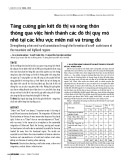
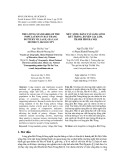

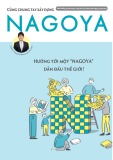
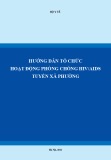
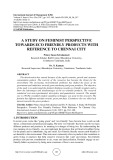
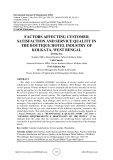
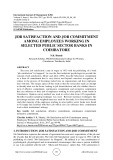
![Bài giảng Công tác xã hội: Khái niệm, phân biệt, quan hệ và chức năng [Chuẩn Nhất]](https://cdn.tailieu.vn/images/document/thumbnail/2025/20251002/littlehippy91/135x160/63461759457333.jpg)
![Tài liệu học tập Nhập môn Công tác xã hội [mới nhất]](https://cdn.tailieu.vn/images/document/thumbnail/2025/20251002/littlehippy91/135x160/50611759457334.jpg)
![Nội dung ôn thi Xã hội học đại cương [chuẩn nhất]](https://cdn.tailieu.vn/images/document/thumbnail/2025/20250930/kisu6910@gmail.com/135x160/12931759283279.jpg)












